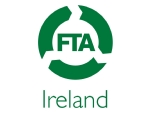
Following the release of Vehicle and Driver Statistics by the Department of Transport, FTA Ireland has called on Finance Minister Michael Noonan to cut freight industry costs and support the fleet sector.
FTAI says high rates of motor tax should be addressed in this year’s budget to prevent Ireland losing more fleet and employees to EU competitors who have lower overheads.
FTA Ireland complimented the Department of Transport on the release this month of its bulletin of Vehicle and Driver Statistics 2014, as the data on commercial vehicle numbers are a reliable indicator of domestic economic performance, and of the direction of our export sector.
The total number of goods vehicles peaked at just over 351,000 in 2008, and had declined to 309,000 by 2012. The trend has been upward since then, with 317,000 goods vehicles on the road last year. Of this total, only 15,587 (5%) operate in licensed fleets. Even in the heavy fleet sector (over 12 tonnes unladen weight) licensed haulage operates only 2,200 vehicles, or 23% of Ireland’s heavy vehicles.
In total, heavy vehicles account for only 3% of Ireland’s commercial fleet. This gives both Paschal Donohoe - Minister for Transport, and Minister Noonan considerable latitude to address the rates of excessive (and uneconomical) motor tax that apply to this sector in this year’s budget.
FTA Ireland General Manager – Neil Mc Donnell said:
“The Government’s figures confirm that Minister Noonan will have to intervene to support our International fleet sector. Ireland is losing fleet and employees to lower cost jurisdictions in the EU. These statistics confirm the message we have conveyed to them for several years now: our cost of business is too high, and is driving transport activity abroad. We ask the Minister to reflect on these facts ahead of the next Budget.”
With 288,000 vehicles, the vast majority (91%) of Ireland’s commercial fleet is in the sub-3.5 tonne weight class, mostly accounted for by vans.
Referring to the figures revealed by the DoT in more detail, Mr Mc Donnell added:
“Ireland is unusual in Europe in that almost 70% of vehicles operate under international licences. This reflects the strength of our export sector. Heavy haulage is the mode by which over 98% of Ireland’s exports reach their foreign destinations. It is therefore of systemic importance to the performance of our economy.”
Ireland’s licensed fleet has increased by 13% since the summer of 2013, while the number of licensed transport operations has fallen by 2% to 3,808 (as of August 2015). The fleet is consolidating into gradually larger operations, with the average fleet size moving from 3.8 vehicles per operator in 2013 to 4.4 vehicles today, an increase of 16%.
This trend is most pronounced in the national-licensed (domestic) fleet, where fleet size has increased from 2.5 vehicles in 2013 to 3.6 vehicles today, an increase of 44%. This reflects the administrative and compliance burden faced by operators today. Running transport operations is an onerous activity, and the amount of work involved does not decrease with the size of the fleet. It therefore makes sense to spread the administrative overhead across bigger fleets. This is taking the smaller operators out of the market.
The fact that the internationally-licensed fleet appears to be consolidating more slowly is not, in our opinion, accidental. The average fleet size in this sector has increased by 6% to 4.9 vehicles, far less than the domestic fleet. This reflects the consistent message FTAI is receiving from the market: commercial vehicles taxes are too high in Ireland, and drivers’ wages are too high. International operators are able to ‘reflag’ their fleets abroad and avail of lower wages and vehicle taxes.